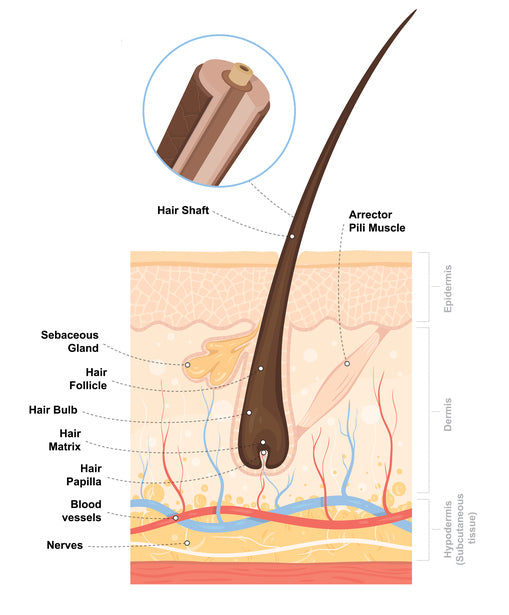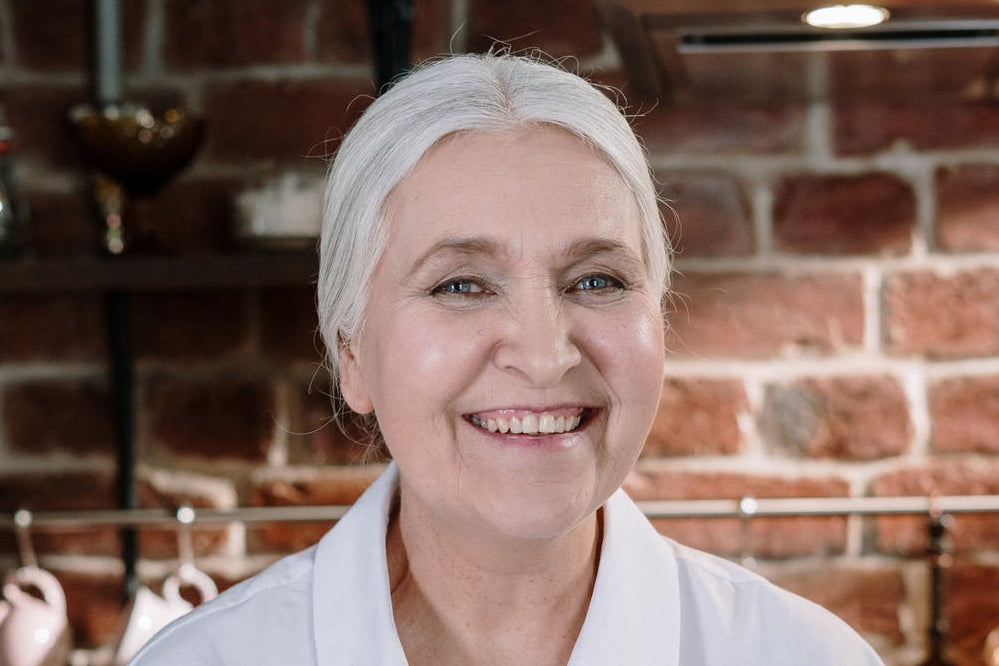Hair follicles are small, pocket-like holes in our skin and they grow hair. The average human has about 100,000 hair follicles on the scalp alone. Understanding the anatomy of hair is essential for understanding the process of hair growth. While hair colour and texture may vary, the actual anatomy of our hair is essentially the same from person to person. Keep reading to learn about hair anatomy and find out how you can make your hair instantly look thicker without waiting for it to grow.
Breaking Down Hair Anatomy
The human body is covered in hair. Most of these hairs are Vellus hairs, which are fine, short and colourless. But certain areas like the scalp, eyelashes and eyebrows have thicker, darker hairs called Terminal hairs.
Vellus hair is short, thin, slight-coloured, and barely noticeable hair that develops on most of a person's body during childhood. Vellus hair is most easily observed on children and adult women, who generally have less terminal hair to obscure it. Each strand of Vellus hair is usually less than 2 mm (1/13 inch) long and the follicle is not connected to a sebaceous gland.
Terminal hairs are thick, long and dark, as compared with Vellus hair. During puberty, the increase in androgenic hormone levels causes Vellus hair to be replaced with terminal hair in certain parts of the human body. These hairs can be found in abundance on the scalp, in the pubic region, under the arms, and on the face (males only).
Each hair is made up of two parts: the hair shaft, which is the visible part of the structure; and the hair follicle in the scalp, which produces and grows the hair shaft.
The Hair Shaft
The hair shaft is the part of the hair anatomy that you can see on the surface of your skin. The hair shaft is primarily made up of a protein called Keratin. Keratin, which is formed from the breakdown of amino acids in the proteins we eat, is also an important component of our skin and nails. This part of the hair structure is non-living, which is why haircuts don’t hurt!
The hair shaft has three parts:
Medulla – a honeycomb-like core made of sugars and amino acids
Cortex – a hard keratin layer that surrounds the medulla
Cuticle – the protective outer layer made up of overlapping keratin scales
The cortex and cuticle contain a pigment called melanin, which determines the colour of your hair.

The Hair Follicle
Otherwise known as the hair root, the hair follicle is the living part of the hair located beneath the surface of the skin. Humans have almost five million hair follicles, 80,000 to 100,000 of which are located on our scalp. The hair follicle is the growth structure that produces the hair, and it also anchors the hair shaft in the skin.
The hair follicle is made up of four parts:
Hair Bulb
The hair bulb is located at the base of the hair follicle. This is where cells divide to form the hair shaft in a continuous cycle of growth and rest, otherwise known as the hair growth cycle. The hair bulb’s anatomy is made up of the papilla and the matrix. The papilla, located at the base of the hair bulb, contains a vascular network that nourishes the hair bulb with nutrients. Through this blood supply, the dermal papilla also receives hormonal signals that help regulate hair growth.
Sebaceous Gland
The sebaceous gland produces an oily substance called sebum that moisturises both the hair shaft and the skin.
The Inner and Outer Root Sheath
These protein structures contain and protect the hair follicle.
Arrector Pili Muscle
The arrector pili is a small muscle attached to the hair follicle. When the arrector pili muscle contracts, it literally causes the hair to stand on end. This is what causes goosebumps.
How the Hair Anatomy Can Affect Hair Growth?
Here are examples of how two parts of the hair anatomy, the hair shaft and the papilla, can affect hair length and hair growth:
Damage to the hair shaft can cause breakage, limiting hair length, which can make it seem like hair growth has slowed down. Following healthy hair care habits like reducing heat styling, chemical straightening treatments and bleaching can help minimise breakage and damage.
If the dermal papilla doesn’t receive proper nutrients from the blood supply, the hair bulb will be less able to efficiently manufacture new hair cells. That’s why eating a healthy, balanced diet is so important for hair growth.
How to Get Thicker-Looking Hair Now
HairMax laser devices are great for hair loss and for conditioning your hair into its best possible condition. There are only three FDA approved treatment for hereditary hair loss. One of them is the Low-Level Laser Therapy or LLLT. Having dedicated over two decades to the research and development of safe and effective laser hair growth devices, HairMax is the first home-use Low-Level Laser Therapy device to be cleared by the FDA for the treatment of pattern hair loss (Androgenetic Alopecia) in both females and males. To date, HairMax has been granted a total of eight FDA clearances! The laser lights emit energy that may increase blood flow and circulation in the scalp. Once the scalp is stimulated by the laser light energy, the hair follicles become healthy and functional again – thereby reversing hair miniaturisation and stimulating new hair growth.




Share:
8 Frequent Hair Loss Myths
Hair Health: Vitamins and Supplements